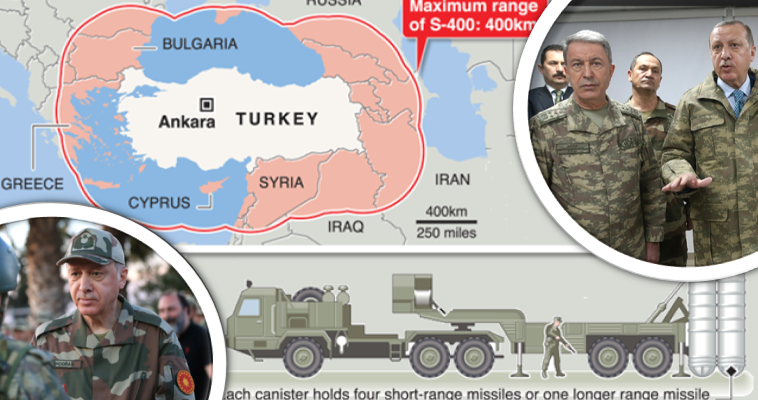Giorgos Margaritis: How Turkey gains without war through weapon procurement
01/07/2020
Weapons systems are usually designed in peacetime. But obviously their use is intended for a time of war. This is a contradiction that relates to the very rich dialogue about the value of one or the other weapon system. In essence, the equipment is designed on the basis of assumptions about what it will be like and what the upcoming war will look like, in which today’s weapons will be called upon to prove their usefulness and value. It is a game of hypotheses where imagination is called to cover the gaps.
In military history, there are many examples where, at the beginning of a real war, high-cost and high-expectation weapons systems disappointed with their performance on the real battlefield. On the contrary, there are plenty of examples where weapons systems, considered obsolete or ineffective in peacetime, have become major weapons of war in the real world. In the latter, the imagination, so necessary in peacetime, gives way to reality. And the rules of the latter are clearly more substantial.
This small theoretical introduction could be a prelude to a general discussion on armaments programs. That is not our intention. In this article we will focus on what policy through armaments can achieve in peacetime. In other words, the way in which the equipment shapes and dictates a political result, without the need for their actual use, in other words during conflict.
Let’s start with distant China. There is a lot of talk about the latter’s strategy, as expressed in the plans of the Road and Belt Initiative” or, if you will, more poetically, in the revival of the ancient “Silk Road”. The literature on these designs is of great concern to Europe, as its main thrusts begin with China, but end up in the European space. They end either on the edge of the Asian hinterland, or on the side of the Mediterranean and its ports (among them Piraeus).
The Pacific as lebensraum (living space)
In essence, however, even a cursory glance at the economic magnitude of China’s expansion would prove that China’s vital interests – and therefore the main strategic goals of its foreign policy – are in the vast basin surrounded by the Pacific Ocean. Indeed, among China’s top ten international customers, seven are in the broader Pacific, while among its top ten suppliers, mainly in raw materials, seven are also located in the Pacific.
The dynamics of the capitalist mode of production – and the relevant centres – have long ago transited to the shores of the Pacific Ocean. The figures show that China’s “living space” lies in its surrounding ocean, not in the west-facing tentacles of the “new Silk Road.” This economic reality dictates China’s military choices.
Its main goal is to first exit towards, afterwards establish an equal presence, and perhaps , later, dominate the deep, cerulean, open seas, of the Pacific. This goal is not easy to achieve. Geography is the first hurdle, and the second is the naval power of the United States and its allies. In the first case, the Japanese archipelago, the island complexes around Taiwan, the Philippines, the South China Sea, come between China and its strategic goal. The combination with the naval power of its opponents makes the problem even more intractable.
Area denial weapons
To deal with this situation, China has developed and continues to develop a number of weapons systems, which we would roughly call “area denial” weapons. These are mainly long-range missile systems capable of hitting targets beyond the island barrier that surrounds the Chinese coast, targeting surface targets, i.e. the warships of its opponents.
The arsenal includes ballistic missiles (DF-21D, DF-26) capable of hitting marine targets at supersonic speeds (in the final phase) at distances of up to 2,000 km, as well as a gamut of shorter range weapons (200 to 400 km), supersonic in the attack phase (up to six times the speed of sound) (CM-401, Yj-12, YJ-18, etc.) that can be launched from ships, submarines, aircraft, or land bases.
In essence, this arsenal creates a threat zone for any naval presence around and behind the zone of the island complexes enclosing the Chinese coast. As the threats increase while the opposing naval presence approaches China, or the strategic archipelagos, a high-risk situation – or the perception of such – arises, where any naval dominance is annulled under the weight of persuasive threats.
In this way, Chinese strategy isolates the island complexes, which geographically buffer it. It reverses the geographical disadvantage, that is, by undoing its complement: the naval power of its opponents. This results in a state of danger and uncertainty beyond the opponent’s front line. It cancels out its strategic importance and pushes its naval supremacy deep into the ocean, where enemy supremacy is almost harmless to China.
It cancels the front, if you will, and takes the game deep into the opponent’s inland sea. By making any opponent’s naval dominance dangerous in the neighboring maritime zones it creates a strategic gap, a gray zone in the direction it is interested in. This kind of de facto “co-sovereignty” paves the way for tomorrow’s simple and obvious Chinese domination of the ocean that is of vital interest to it.
The target is the Eastern Mediterranean
But let’s go back to the warm seas of Greece’s neighborhood to connect what is happening in faraway China with what directly concerns us, the Aegean or the Eastern Mediterranean. In this case, the stakes are not the whole ocean, but a closed, very closed, sea. Turkey’s insistence on acquiring the S-400 system conceals a strategic approach similar – relatively – to that of China.
Contrary to what is happening in the Pacific, the problem of Turkish politics is focused on the airspace and not on the seas. The reason is obvious. The challenge of air domination is that in the narrow Aegean-Eastern Mediterranean will create a strategic and therefore a political result. Russia’s “unknown”, to the West, arsenal will create a network of threats for anything flying between 40 and 400 km off the Turkish coast.
These threats will multiply as any opponent approaches the Turkish shores. The S-400 system includes missiles with a range of 40 km (9M96E) and 380-400 (40N6E). In essence, it creates successive barriers to rival aerial means. The political outcome is similar to what China is achieving in its neighboring seas, only closer to Greece.
The isolation of neighboring islands and archipelagos in Turkey, the creation of a “dangerous zone” deep in the Eastern Mediterranean, produces a political effect. The creation of a gray zone in the air cancels de facto the domination of “annoying neighbors” or any force that wants to dictate political solutions in the region. The notion of sovereignty is thus becoming vague, and the way is open for the next milestones in the politics of claims.
Greece’s “we will procure”
In the United States, the debate over how to deal with the Chinese strategy has peaked with no functional answers. It would be an exaggeration to ask the Greek political and military elites (closely tied to the former) to formulate strategies to deal with the moves of Turkey. We have heard that Greece will procure frigates, F-35s, submarines and missiles.
This schizophrenic and haphazard “we will procure” is projected as if Greece is looking to buy presents for five-year-olds. No talk about national defense issues and strategies. These are annoying issues when one has to keep voters happy and at the same time placate Greece’s various “allies” who sell weapons.
Turkey buys weapons in order to achieve political and strategic results in peacetime. In fact, without the need for any system to prove its worth in battle. Maybe, I say, instead of constantly berating our neighbors, we should start learning from them. At least as concerns weapon systems and politics, that is, the basics…





